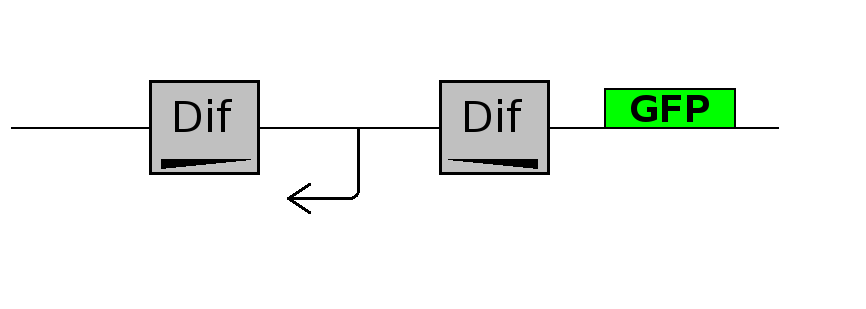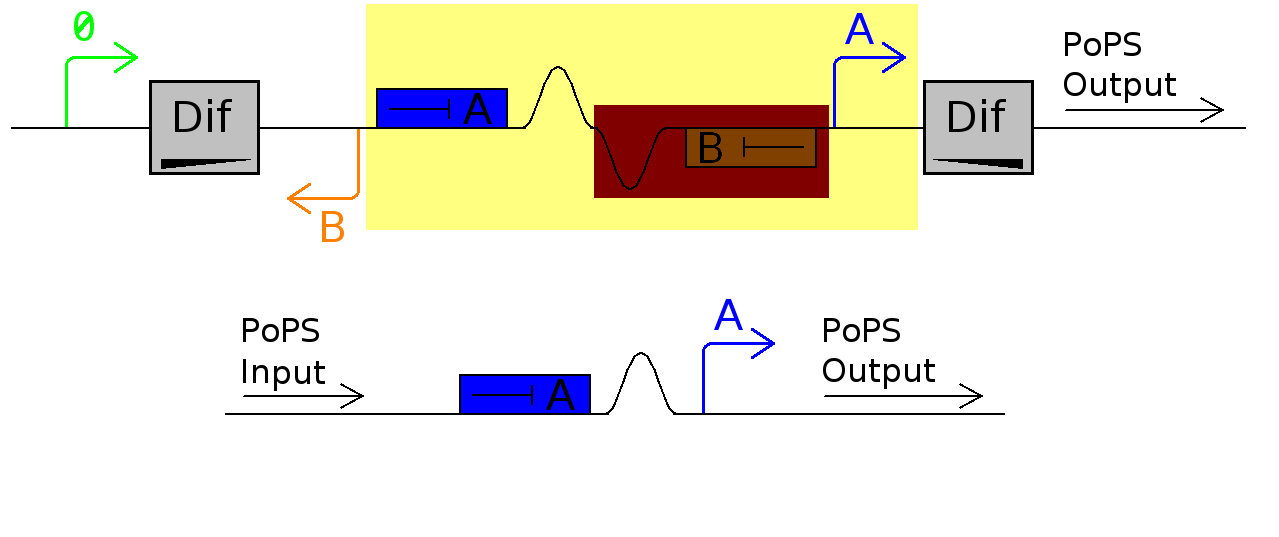Edinburgh/DivisionPopper/Design
From 2007.igem.org
MENU : Introduction | Background | Applications | Design | Modelling | Status | Conclusions
In the Design section we define the architecture (design), the biology elements (implementation) and the mechanisms (dynamics) of the device. According to the abstraction levels hierarchy, we propose the view of the Division PoPper at the level of device, parts and DNA. Regarding to the dynamics we explain which are the biological processes involved and how they cooperate in defining the behaviour of the device. The logic design and implementation phases have been decoupled.
Contents |
Design
In this section we explain which are the functional components of the device and how they are connected logically and physically. The view on the device is given following the abstraction hierarchy proposed in the Registry of Parts.
| Device abstraction level of the Division Counter |
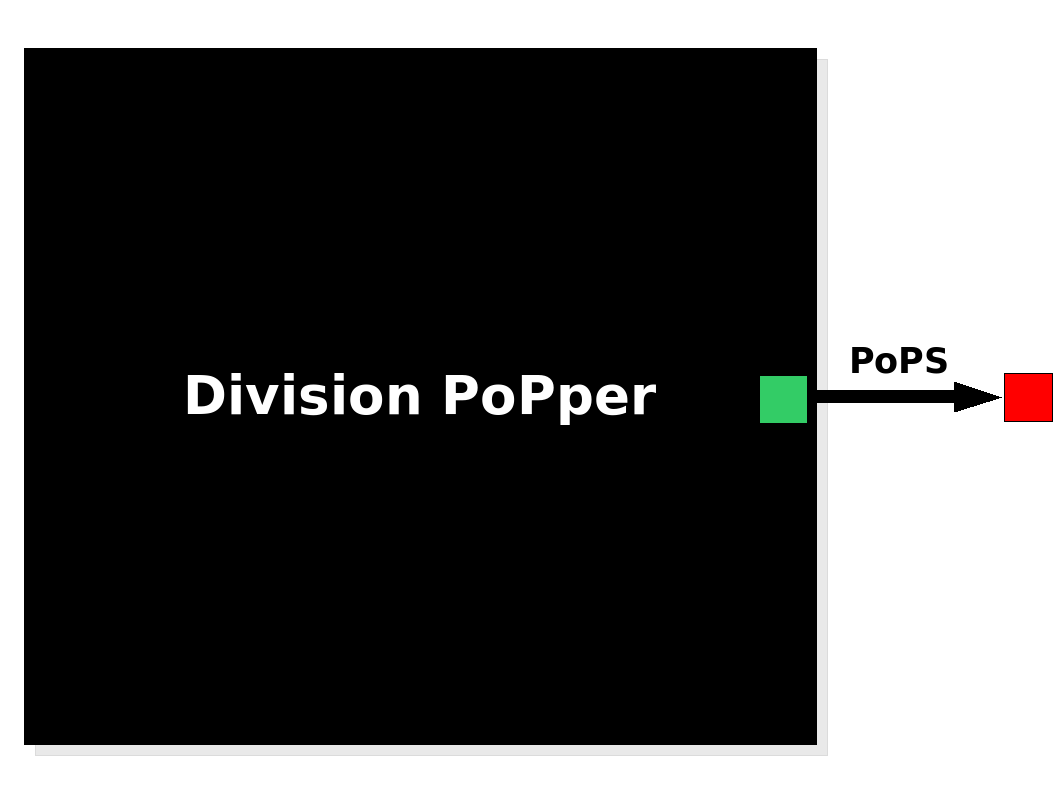 The Division PoPper device generates an input in the form of PoPS signal. The Division PoPper device generates an input in the form of PoPS signal.
|
Device abstraction level
The Division PoPper is a device, because it is a functional element that can be further compose with other devices by the use of a standard PoPS signal. The device has no formal input but its behaviour is triggered by an "external" stimulus: the cell division. The output is a PoPS signal that is supposed to be always zero (not considering leaking issues in the promoters) apart when a cell divion happens. In this case the device generates a pulse: the PoPS signal reaches a non-zero level for a period of time, returning to zero value afterward. The function of the device is simple: to inform a downstream device that a division happened by sending a pulse signal. We suggests some systems configuration in the Applications section.
| Part abstraction level (Design) |
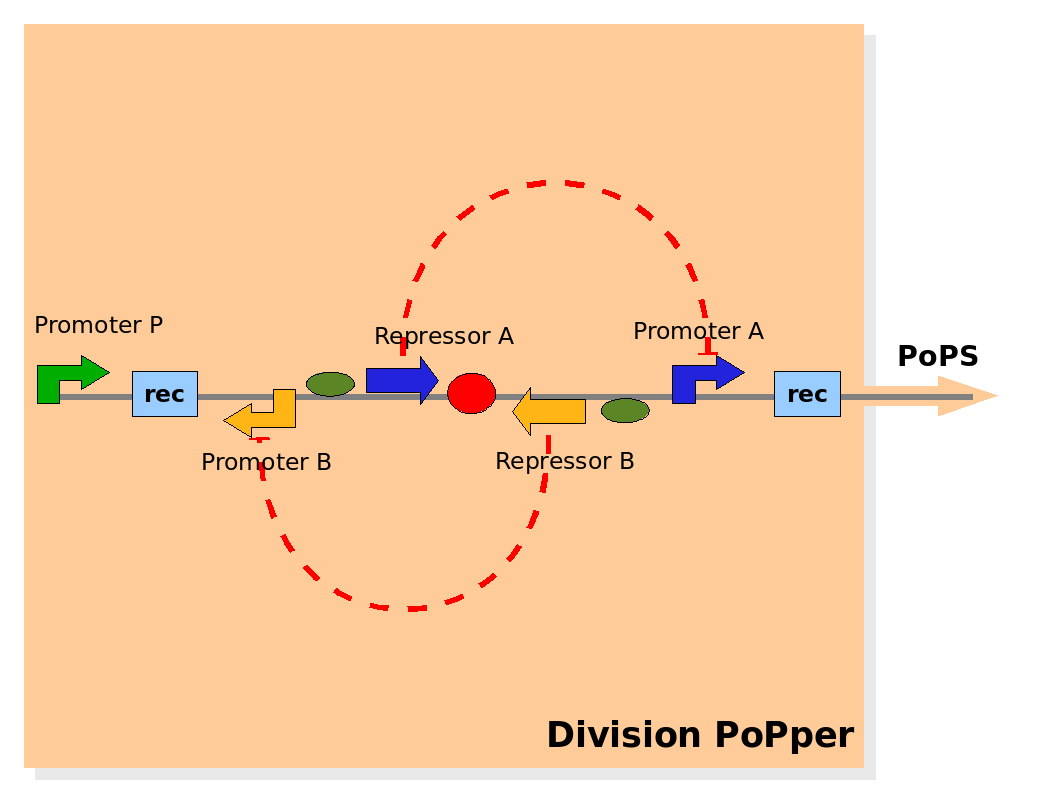 Design of the part structure in the Division PoPper device. Design of the part structure in the Division PoPper device.
|
Part abstraction level
At the level of part abstraction we define the functional parts of the device: regulatory regions, coding regions, terminators and so on. Instead of proposing directly the actual biological entities, we propose here a logic view. Strictly speaking, we defines entities by their attributes and abilities, but without mapping them to real biological objects. This is done then in the Implementation section below. The motivation is to separate the functional design from the realization choices.
The Division PoPper functional parts are:
- two recombinase site sequences: Rec.
- a promoter A that can be repressed by protein A: promoter A.
- a coding region for protein A: repressor A.
- a promoter B that can be repressed by protein B: promoter B.
- a coding region for protein B: repressor B.
- a promoter P that is constitutively active (expressing).
The functional ability that these entities should have are:
- the region between Rec recombinase site sequence is flipped (reversed horizzontally and vertically) at each cell division.
- the protein A and protein B degredation rate should be fast enough to degrade them rapidely when not expressed.
- the protein A and protein B effects on (respectively) the promoter A and B expression capacity should be strong.
- promoter P should be strong in is constitutive expression.
The physical configuration:
The design relies on the alternate expression of the two strands of the DNA segement in between the Recombinase sites. Promoter P is placed outside the "flipping region" and controls its downstream region in the upper strand. The output of the device is given by the PoPS activity on the upper strand downstream the last recombinase site. Since the region in between the recombinase sites is flipping, the output is controlled alternatively by the two DNA strands. In one, parts sequence is: repressor A, terminator, Promoter A. In the other the sequence is: repressor B, terminator, Promoter B.
| Device abstraction level of the Division Counter |
| 350px The Division PoPper device generates an input in the form of PoPS signal. |
The dynamics:
As cell division occurs, DNA enclosed by two inverted Rec sites is reversed. Initially there is no Repressor B present in the cell so Promoter B produces PoPS output. As time passes, Repressor B production is turned on and 'turns off' Promoter B. Meanwhile Repressor A is no longer produced and degrades so that, at the next division, Promoter A can produce PoPS output and the process repeats.
Implementation
In the previous section we define which functional components are needed at the level of parts. In this section the members with biology competences evaluate the design and identify the actual biological parts that can be used. Further on the DNA abstraction level details are proposed.
| Part abstraction level (Implementation) |
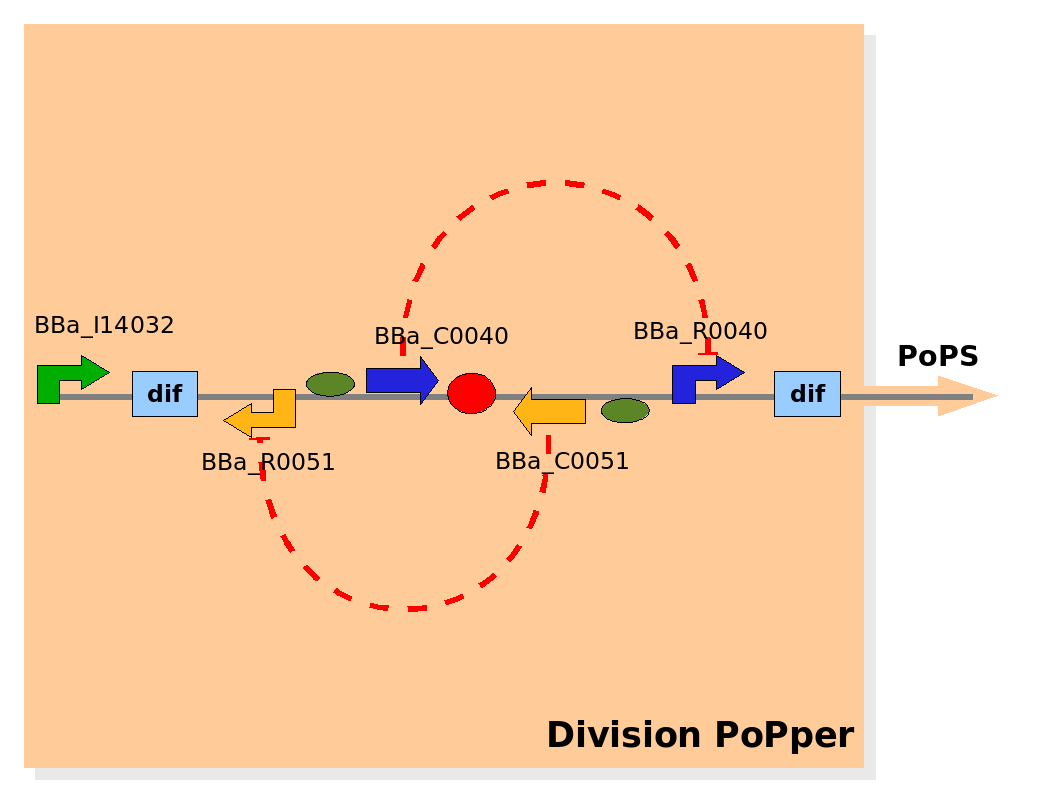 Implementation of the part structure in the Division PoPper device. Implementation of the part structure in the Division PoPper device.
|
Part abstraction level
The Division PoPper parts are:
- two Dif recombinase sites (design: Rec).
- Tet promoter (design: promoter A).
- TetR repressor (design: repressor A).
- CLambda promoter (design: promoter B).
- CLambda repressor (design: repressor B).
- Lac promoter (design: promoter P).
The Registry of Standard Parts contains already some of the elements we need, for the others we constructed and added their Biobricked version.
The Division PoPper parts registry entries are:
- two Dif recombinase sites:
- Tet promoter:
- TetR repressor:
- CLambda promoter:
- CLambda repressor:
- Lac promoter:
The assumption are:
Assumptions:
- The Dif sites flip only once during each cell division
- Repressors A and B are produced and degrade faster than the cell cycle
- Promoter B does not interfere with production of repressor A
For this device to work, dif site-enclosed DNA needs to flip but once per division. Like all recombination sites, dif-sites are directional and bacteria uses directly repeated dif-sites to resolve genome dimers. Research shows that this resolution occurs only at septation, and we use this temporal control to inverse a plasmid-kept sequence to induce different functions. In its current configuration, Promoter A is repressed by continually produced Repressor A. At this time, no Repressor B is produced.
DNA abstraction level
Biology Processes
Use of the Edinburgh Pathway Notation to express the biological processes.
Proof of Concept
YFP (BBa_E0430)
As stated before, the device relies on the dif site flipping only once per cell division. To test whether or not this actually happens, we have devised two simpler experiments.
Exp 1
This experiment will prove whether or not the DNA between the two dif sites flip at all during cell division. If the a flip occurs, then the direction the promoter operates will be changed and GFP will be expressed.
Exp 2
This investigates the number of flips that occurs during division and will require rapidly degrading fluorescent proteins.
After each division we expect to see a change in colour as the promoter activates a different reporter.
Exp 3
Currently we are planning to test how the dif sites flip using exps 1 & 2. The final device requires a few more parts, each of which needs to be tested.
We might wish to test the repressors without the dif sites
The repressor part of the system is simply a pair of inverters.
There are 3 basic types of inverter in the registry:
- TetR BBa_Q04400 “this inverter functions well. [jb, 5/24/04]”
- CI (Lambda) BBa_Q04510 “this inverter functions well. [jb, 5/24/04]”
- LacI BBa_Q04121 "a strong 'on' state with significant background in the 'off' state. [jb,5/24/04]”
exp 3 design
This will test to see if promoter B causes problems with promoter 0's promoting repressor A and tests the standard repressor inverter found in the registry.
Parts required:
- Promoter 0 – suggest BBa_I0500 (arabinose) – Plate 2, 9I
- Promoter B – reverse complimentary lacI promoter – Used in exp 1
- Inverter – suggested BBa_Q04510 (CI (Lambda)) – Plate 2, 13K
- Reporter – use same as experiment 1
Biobricks Required
Biobricks From Registry
| Part | For use in | Brick used |
|---|---|---|
| Reporter | Exp1, Exp2, Exp3 | BBa_E0422 - Fast Degrading ECFP |
| Inverter | Exp3 | BBa_Q04510 - CI (Lambda) Inverter |
| Promoter 0 | Exp3, Final PoPper | |
| Promoter A | Final PoPper | |
| Repressor (+RBS) A | Final PoPper | |
| Central Terminator | Final PoPper |
Biobricks requiring construction
| Part | For use in |
|---|---|
| Dif sites | Exp1, Exp2, Final PoPper |
| Reversed Promoter B | Exp1, Exp3, Final PoPper |
| Reversed Repressor (+RBS)B | Final PoPper |
